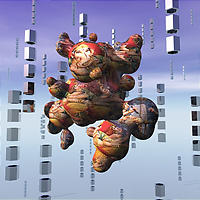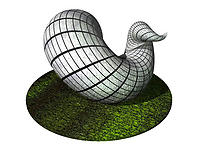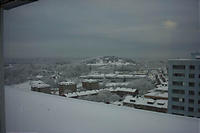January 29, 2006
A Nicely Alien Curry
 A review of River of Gods by Ian McDonald.
A review of River of Gods by Ian McDonald.
Is this the big Indian sf novel or just a case of orientalism? I really can’t decide. But it is a fun read.
The structure is very Bollywood: a teeming person gallery, a number of character whose destinies become intertwined, hopeless loves, betrayal, dilemmas, war and a final chapter where the whole ensemble does a song-and-dance number. OK, maybe not literally, but the climax has enough action and melodrama to fit.
It is all set in a mid-century future India divided into a number of independent states. Bharat, with capital Varanasi, is suffering from drought due to the lack of the Monsson and growing political unrest. In the booming local economy people are happily cutting corners on AI safety and building power production empires based on appropriate technology. AI is used for everything from military vehicles over soap operas and personal soundtracks (a real visionary killer app) to the construction of alien emotions for use as drugs. Gender selection has produced an intense marriage shortage, changing society in unpredictable ways. At the same time old traditions are still observed and Hindu nationalism is a vivid force.
Is this how a future India would be like? I can’t say I feel I understand Indian culture very well. I have a hard time understanding the very romantic aspects of it, and I am not familiar with the intellectual discourse within it. So when reading the book I just enjoyed the ride, fairly convinced that the author knew more than I did when giving detailed looks at odd corners of life. Compare the bloodless description of Oxford (just place names, essentially) with the first chapter’s overview of Varanasi. But like most sf this is probably a better description of the present than the future. India seems already to be Bahrat.
While China does a prickly-but-mysterious number, India seems more open culturally. As the link between the West and India intensifies year by year, it is no coincidence that one may hear bhangra at European clubs or have German-speaking Indians protest against the hiring of Germans at a call-centre. I would predict that we are going to see a lot more Indian-themed sf soon.
Where the book really stands out is the AI and nutes. The AIs are pleasantly alien, not at all the usual “human in a box” most writers make them. These entities really do have a completely different mode of existence. There is the slight cliché of humans fearing and harassing the downtrodden software and sending special police after rogue copies, but Mr Nandha the fussy Krishna Cop is a great character light-years away from Deckhart. And the big AI characters consistently surprise, especially by being fallible superintelligences.
Nutes are a new sex, neither male, female, both or asexual. While McDonald does not go deeply into their lives (that would presumably take collaboration between Greg Egan and Ursula leGuin) they offer an intriguing glint of something very different. Still, beyond being beautiful, sensual and strange their presence doesn’t change anything hugely in the setting. The same goes for the Ais and Brahmins (genetically modified people ageing at half normal speed, with some nasty psychological effects of being adult in children’s bodies). But this might not be a case of lack of integration into the setting but rather a sign of how the setting has not yet adapted - there are signs everywhere (and characters comment on it) that society has become distorted and that something must change sooner or later.
In the end the book is an idea overload just like India often gives sensory overload. I like books that instead of taking a single idea and exploring its consequences in detail (that usually works best in short stories) play around with a huge set of new ideas and leave them for further pondering afterwards.
January 25, 2006
Fast and Hungry
Caesar was maybe right in distrusting Cassius for his lean and hungry look. This monday I attended a lecture by Yael Niv on response vigor in reinforcement learning. The traditional reinforcement learning model is great at describing how to learn or prescribe what to do for an agent trying to maximize rewards through its actions. But in reality we do not just select what to do, but how strongly to do it: an eager gambler at a slot machine is rather different from a non-gambler trying to get rid of change.
She had a nicely extended reinforcement model where the agent chooses the action and latency with which to perform it. Acting with a short latency incurs a higher cost than doing it with a long, but if one acts slowly rewards come less often. She then applied it to experimental data from hungry and less hungry rats in Skinner boxes with various reinforcement schedules (PPT link), getting plausible results. Hungry rats reacted faster, not just on actions leading to more food but on other actions too. The model even explicitely predicted the optimal latency based on the average reward over time and the cost of actions, something that ought to be testable in many nontrivial ways.
I skipped lunch that day, so I really felt with the hungry simulated rats. Personally I agree with the model: when I am hungry I tend to react faster even on tasks unrelated to hunger. Might be a good idea to develop into an efficiency-increasing and health-promoting system.
The Economic Beauty of Seashells
 A review of A Natural History of Shells by Geerat J. Vermeij.
A review of A Natural History of Shells by Geerat J. Vermeij.
While the Algorithmic Beauty of Seashells by Hans Meinhardt focuses on the patterns of the shells, this book is about their substance.
Why care about seashells? Because they are a made of a natural organic-inorganic composite material with fairly impressive physical abilities. Their long evolution has found many clever solutions to design problems we can exploit when we start building using the same principles. In the end much of our technology might end up borrowing ideas from the self-assembly and clever structural strength maximising microarchitecture. And they are of course marvellously beautiful.
A key point is the author’s questioning of the often assumed optimality of evolution. It is common to assume that since individuals of the same species compete with each other evolution will lead to locally optimal designs. If a design isn’t optimal in respect to a factor we will tend to look for some other factor that shows the extended system to be in an optimal state. But he points out it might be enough to be better, not the best: for many properties the evolutionary drive might saturate once a problem is solved, and other factors become more important to optimise.
An example might be shell composition: since the calcium carbonate in shells tends to dissolve in cold seawater it would be efficient to use calcite rather than aragonite shells in cooler regions. They are indeed more common, but there are many exceptions. Instead the dissolution can be counteracted by a covering skin (periostracum) or symbiotes, or just accepting a certain amount of dissolution.
The main issue for the snails seems to be predators rather than achieving economy in building. A strong defence may be more economical than a weaker defence despite the metabolic cost. But again, the solutions to the problem of not being eaten are manifold and seem to change with surprising speed. In a very interesting chapter near the end (the chapter order of the book did not feel entirely logical) he discusses how the different tropical and arctic shells differ. Even a relatively short evolutionary period like the one after the sealing of the Panama isthmus seems to have allowed radical differences in strategy on its sides.
Another mystery is why most but not all shells curve the same way. Individual shells are occasionally found reversed. In the evolutionary past there have been families curved both ways, and there are recorded transitions between left- and right-handed forms, even inside the same species. But most go from left to right. There are tantalising hints that there is some particular advantage to being right-handed, but they are hardly certain.
It is interesting to read the nature descriptions made by a blind naturalist: they are vivid and personal, and were it not for the complete absence of references to colour they would seem entirely normal. I just wonder how he perceives the swimming movements of scallop shells.
When I started this review I did not know that he had written a new book, titled Nature:
An Economic History that seems to continue the thoughts in this one. I definitely think I will look it up.
January 22, 2006
We gonna run run run to the hospitals of the future
I muse a bit on CNE Health about the hospital of the future. This is work partially based on ongoing writing for a rpg. For space reasons (I'm CNE's most longwinded blogger) I left out the enhancement spas: spend your medical holidays surrounded by relaxation as you get your bacterial microflora tuned, add some extra neurointerfaces, flush your mitochondria and have your memetic advisor suggest new constructive ways of thinking.
From point A to Point B
Sorry for the lack of updates, but I have been relocating myself and parts of my exoself from Stockholm to Oxford.
I am now working at the ENHANCE project with the philosophy of cognitive enhancement. I'm located at The Oxford Uehiro Centre for Practical Ethics and working together with The Future of Humanity Institute. You will be reading a lot of spin offs from this work, I'm sure.
Now I only have to overcome the minor complications of bank bureaucracy, weird little penny coins and how to make my room liveable.

